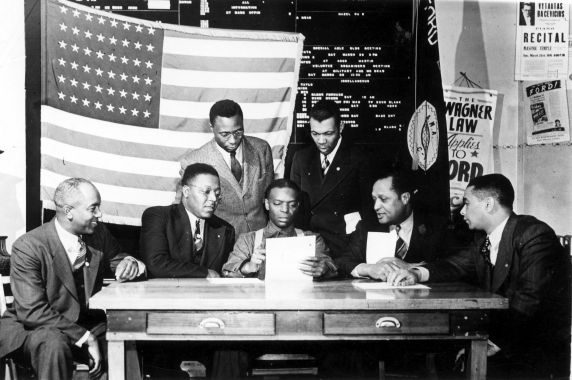Black autoworkers were critical to unionizing Ford
Black History Month
With the victory of the 44-day Flint Sit-down Strike on Feb. 11, 1937, General Motors was forced to recognize the United Auto Workers union as the representative of GM workers. In March of 1937, a sit-down of thousands of Chrysler workers in Detroit won a similar victory.

Black UAW leaders prepare for 1941 Ford strike. Standing, Christopher Alston and Clarence Bowman; seated left to right, Joseph Billups, Walter Hardin, Veal Clough, Leon Bates, John Conyers Sr. (Photo: Walter P. Reuther Library)
Ford, however, remained intransigent and refused to allow the UAW to represent its workers. It took a powerful strike in 1941, in which Black autoworkers and community leaders played a critical role, to unionize Ford.
Chrysler, GM and Ford — called “the Big Three” — combined accounted for about 90% of all U.S. vehicle sales that year. The auto industry was critical to the expansion of capitalism. And organizing the entire auto industry was critical for the future of unionism in the U.S.
The number of Black workers at Ford was, comparatively, much larger than at GM or Chrysler. Ford was able to buy a measure of loyalty from its African American workforce through the company’s relationships with Black clergy and the Detroit chapters of the NAACP and the Urban League. A referral from a prominent pastor or one of those two organizations was the best path to a job at Ford — although for Black workers it usually meant being put on the hardest, dirtiest jobs in the plants.
A number of Black workers were skeptical of unions, including the UAW. The American Federation of Labor — from which the Committee on Industrial Organizations (later the Congress of Industrial Organizations, expelled from the AFL in 1937) was formed in 1935 — had many affiliate unions that did not even allow African Americans to become members.
The UAW had split into two unions, UAW-AFL and UAW-CIO, both of which tried to win Black workers to their side. The UAW-CIO, officially took an anti-racist position, but some potential members didn’t think the union was doing enough to fight for equality in GM and Chrysler plants.
Nevertheless, the UAW had on its organizing staff a group of dedicated Black organizers, including Christopher Alston, Leon Bates, Joseph Billups, William Bowman, Johnson Buchanan, Veal Clough, John Conyers Sr. (father of the late representative from Detroit, who served 52 years in the U.S. Congress), Walter Hardin, Percy Key and Paul Kirk. Most of these organizers were from plants in Detroit and around Michigan. There were also worker-organizers in the plants, some of whom held elected office.
Al Johnson, Tanner Perry, Horace Sheffield and Shelton Tappes were among the strongest union supporters in the Ford Rouge complex. When the strike began on April 1, 1941, after Ford fired eight unionists, the UAW-CIO had won over a section of Detroit’s Black leadership. Now the UAW-AFL was firmly in the pocket of Henry Ford and supporting a phony “back-to-work” movement.
With the national NAACP officially supporting the UAW and the Detroit NAACP youth under Sheffield’s leadership backing the union drive, even the Detroit NAACP chapter was shifting its position away from its earlier praise for Henry Ford and his phony benevolence.
Ford bosses were able to convince thousands of workers, including a disproportionately high number of Black workers, to stay in the plants when the strike began. Concerted appeals from the UAW-CIO’s Black organizers, promising that workers would not be attacked if they exited the plants, convinced some of them to come out, join the picket line and sign up as union members. But too many Black workers remained inside, creating a possibility that Ford would exploit racial divisions and instigate violent strikebreaking.
Beginning April 2, Sheffield and the NAACP youth division made passionate appeals from the UAW-CIO sound car to the Black workers inside and in the neighborhoods. They urged their peers “not to permit any of their race to be made the catspaw of a conscienceless company,” accusing Ford of “inciting racial hatred … to break the ranks of its striking employees.” (“Black Detroit and the Rise of the UAW,” by August Meier and Elliott Rudwick)
Then NAACP leaders — even national Executive Secretary Walter White — along with the minority of prominent Black clergy who had long been pro-labor, joined the voices supporting the union — or at least professing neutrality.
Finally, after 10 long days, Ford agreed to allow an election where workers would decide the question of UAW representation. The union won handily. On June 20, 1941, Henry Ford and Harry Bennett — who headed up Ford’s hated goon squad, the “Service Department” — signed a contract with the UAW.
Black union leaders made this victory possible.

